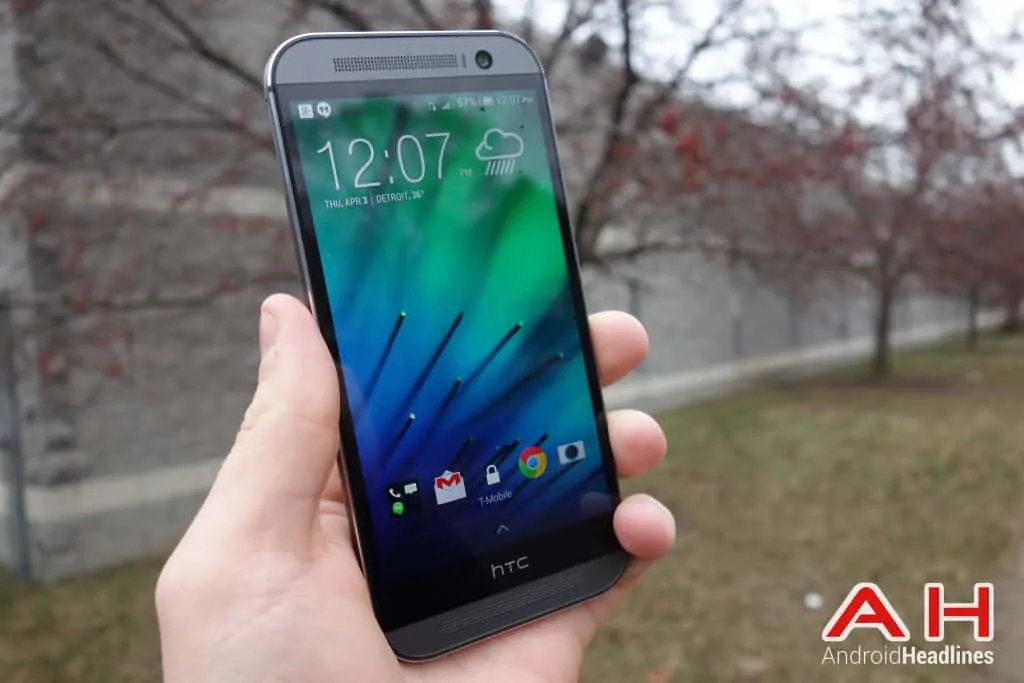Introduction
We have a good one for you today – the new kid, the HTC Desire 820, off the old block, the HTC One M8. When the beautiful HTC One M7 came out a couple of years ago, it started our love affair with metal and smartphones that was continued with this year’s One M8. It also redefined that way that an HTC smartphone looked and this can be seen even in HTC’s latest Desire 820 – only a mid-range phone in a plastic format. Even though the Desire 820 is all-plastic and the HTC One M8 is all-metal, they both feel solid and well-built, not to mention very nice looking.
With both models coming from HTC and designed very similar, you would expect these two devices to be very much alike when it comes to specifications. The displays and processors are different, but they both come with 2GB of RAM, and you can grab 16MP of internal memory and both devices have a microSD card slot to add an additional 128GB of internal storage. The camera areas are very different, but both devices have the exact same 2600mAh battery.
The HTC Desire 820 is about 4/10-inch taller and wider, due to the larger display, but the smaller HTC One M8 is about 5 grams heavier. They both come with dual-band Wi-Fi, Bluetooth 4.0, and have a microUSB 2.0 plug for charging and data transfer. HTC even included their famous dual front-facing stereo BoomSound speakers, a built-in FM Radio and the both come with Android 4.4.2 with Sense 6.0 (HTC One M8 was updated to 4.4.4).
Please take a look at the detailed specification table shown below and you will get a good idea exactly how these two devices compare. After that, we will take a more detailed look at each individual device, look at its pros and cons, and try to pick a winner of this comparison…can the flagship HTC One M8 still hold its own up against the new Desire 820?
Specifications

HTC Desire 820
HTC took their popular One M8, swapped out the metal body for a plastic one, gave it a larger display and threw in a 64-bit processor – possibly targeted only for the Asian market. We are hoping that HTC will bring the Desire 820 to the U.S., although it may be used as a high-end pre-paid device for one or more of the carriers.
The HTC Desire 820 comes with a 5.5-inch HD LCD display with a resolution of 1280 x 720 pixels and 267 pixels-per-inch (PPI) – one-half inch larger than the HTC One M8, but with a lesser resolution. Both devices use a Snapdragon processor, although the Desire 820 uses a new 64-bit processor, the 615 octa-core clocked at 1.5GHz and 1GHz, versus the 32-bit higher-end 801 quad-core clocked at 2.3GHz found in the HTC One M8. Like I said earlier, they both use 2GB of RAM and the Desire 820 has 16GB of internal memory – the One M8 has a 16GB and 32GB model, but with both offering a microSD card for an additional 128GB, the 32GB model is a moot point.
The camera area of the Desire 820, like all Desire models, is a far departure from the UltraPixels used on their One M8 – the camera’s used on the Desire 820 are the typical 13MP sensor with auto-focus and an LED flash for the main camera and a huge 8MP front-facing camera (FFC) for social selfies or video chatting. The 2600mAh battery is rather small, although will certainly make it through a full day of normal usage.
The Desire 820 is rather a large device and definitely a two-hander and in comparing it to the One M8, you will notice the extra wide and height right away. The Desire 820 is also a Dual-SIM smartphone, so it can be used on more than one network – quite common in Asian countries. It comes in a multitude of colored two-tone shells, which make it very attractive and the device feels well made.
HTC One M8
 The HTC One M8 was a hit, with reservations when it first came out earlier this year – its looks were universally liked, but techies were hoping for a better display, faster processor, more memory, a larger camera, not a Duo-Camera, and a larger battery.
The HTC One M8 was a hit, with reservations when it first came out earlier this year – its looks were universally liked, but techies were hoping for a better display, faster processor, more memory, a larger camera, not a Duo-Camera, and a larger battery.
The One M8 comes with a 5-inch Full HD (FHD) Super LCD3 display with a resolution of 1920 x 1080 pixels and 441 PPI – much better than the 267 PPI found on the Desire 820. The Qualcomm Snapdragon 801 quad-core clocked at 2.3GHz is only 32-bit, but a much faster and more advanced processor. It still uses the same 2GB of RAM and either 16GB or 32GB of internal storage, but also has a microSD slot to add up to 128GB of additional storage.
HTC took a different stance when it comes to the main camera – starting with the HTC One M7, they started using a 4MP camera with what they call UltraPixels…larger than normal pixels, although, the idea didn’t really pan out in actual testing with just good pictures. We were hoping that the HTC One M8 would either have 8MP UltraPixels or that HTC would just go back to a regular megapixel, but instead they left the main camera as is, and added a second camera and called it a Duo-Camera, for special effects, such as adding more depth to your photos. Again, it was not a real improvement in the photo quality, but an interesting concept. The new HTC Desire line has been supporting a more conventional megapixel standard – possibly, they will do the same thing with the next HTC One M9. The One M8 does have a great dual-tone LED flash with auto-focus and it has a nice 5MP FFC for selfies and video chatting. The HTC One M8 shares the same 2600mAh battery, which does last about a full day.
Other than the metal casing, the One M8 does have an IR Blaster, Stereo FM radio, a TV-out via a MHL A/V link, and although it came with Android 4.4.2 with Sense 6.0, it recently received its 4.4.4 KitKat upgrade. The HTC One M8 is available on all major U.S. carriers and will cost you $199 on a two-year contract, although you can find it discounted at times.
…And The Winner Is…

Summary
Even though it is an older model, the HTC One M8 is the definite winner of this comparison…it has a smaller, but better display, a beautiful metal body, a faster processor, better graphics chip, as much RAM and memory options, an odd, but more effective main camera and even the smaller FFC takes better selfies. It also has the dual-tone LED flash, the same size battery, easier to handle, NFC capable, IR Blaster, upgraded Android, availability and a great price.
The mid-range Desire 820 is a great idea, but the execution is not what we were hoping for – the 720p is a tad small for a 5.5-inch display, and though touted as a great photo taker, it is only of an acceptable quality, especially the 8MP FFC. It does offer the BoomSound and the Dual-SIM, but the quality and great pricing of the HTC One M8, make it the winner of this comparison.
Please hit us up on our Google+ Page and let us know which one you would pick as the winner and WHY…as always, we would love to hear from you.


